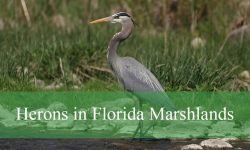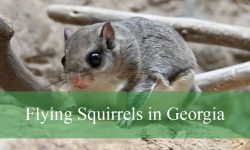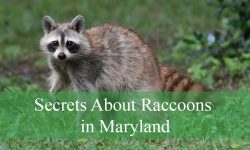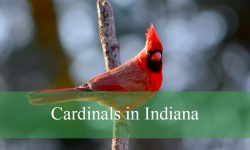Ducks are one of the most diverse and fascinating groups of waterfowl found worldwide. With their vibrant colors, unique behaviors, and adaptability to various habitats, ducks are a favorite among birdwatchers and nature enthusiasts. In North America, especially across the United States, there are numerous types of ducks that can be spotted throughout the year. From the colorful Mallard to the elegant Northern Pintail, these birds are not only beautiful but also play vital roles in their ecosystems.
Understanding the different types of ducks is essential for identification and appreciation of their diversity. In the U.S., ducks can be broadly categorized into dabbling ducks, diving ducks, and perching ducks. Dabbling ducks, like the American Wigeon and Blue-Winged Teal, feed on the water’s surface, while diving ducks, such as the Canvasback and Bufflehead, plunge below to catch fish and aquatic invertebrates. Perching ducks, like the Wood Duck, are known for their ability to perch on branches and nest in tree cavities.
This comprehensive guide explores 49 of the most popular types of ducks found in North America, highlighting their unique features, habitats, and behaviors. Whether you’re exploring wetlands, lakes, or rivers across the U.S., this article will help you identify and learn more about these remarkable birds.
Different Types of Ducks
American Black Duck
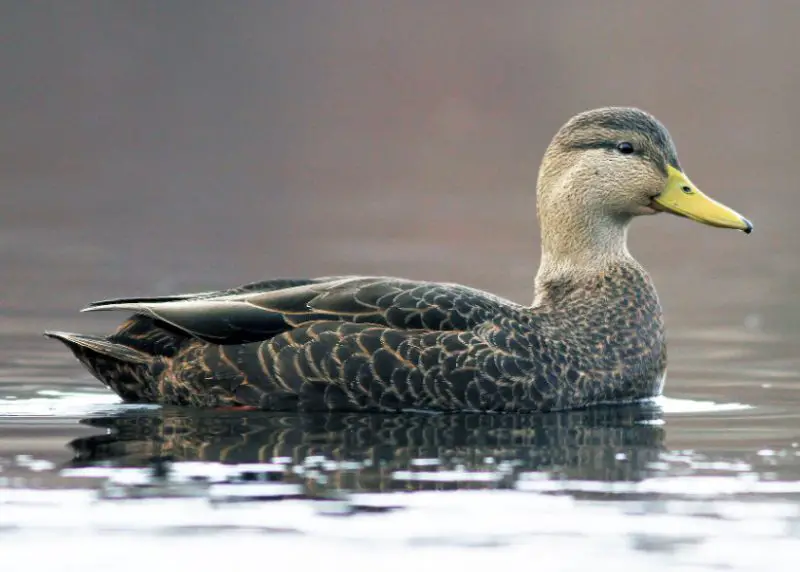
Although they are named American Black Ducks, these birds are actually dark brown with black markings. A distinctive feature is the horizontal black stripe near their eyes. Male and female American Black Ducks can be easily distinguished from one another. Males have lighter heads and bright yellow bills, while females have darker heads and pale olive bills. Their plumage helps them blend into their wetland habitats, providing excellent camouflage from predators.
American Black Ducks are known for their shy nature, often avoiding human activity. They are commonly found in wetlands, including marshes, swamps, and coastal bays throughout the eastern United States. These ducks are dabblers, meaning they feed at the water’s surface rather than diving. Their diet mainly consists of aquatic plants, seeds, and small invertebrates. Conservation efforts focus on preserving wetland habitats to ensure the survival of this species.
American Wigeon
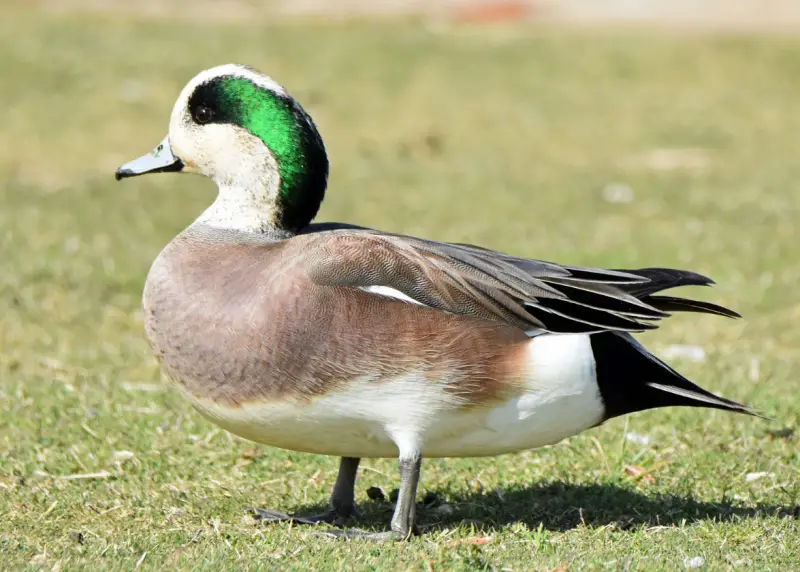
The male American Wigeon is known for its striking appearance, featuring a vivid emerald patch around its eye and a white crown that looks like snow dusting his head. The rest of his body showcases shades of light brown, gray, and black. In contrast, the female is more subdued in color, with a light tan body adorned with darker brown markings and a dark smudge around her eye. Both sexes share a short bill ideal for grazing on vegetation.
American Wigeons are noisy ducks, frequently making whistling sounds. They thrive in wetlands, lakes, and marshes across the United States, except Hawaii. These dabbling ducks prefer to feed on aquatic plants and grass, making them common visitors to fields and shallow waters. They are highly migratory, moving southward during winter, and can be found in large flocks, often mingling with other waterfowl species.
Black Scoter
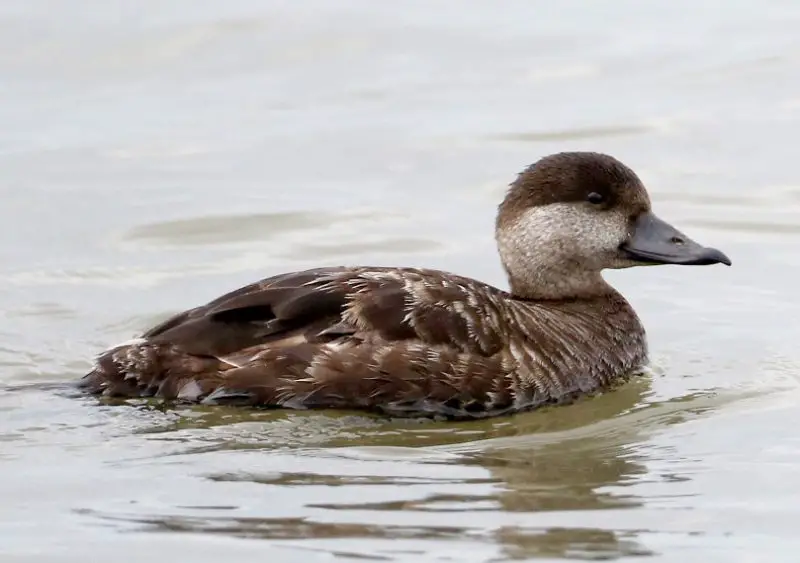
The Black Scoter is one of the least colorful male ducks, characterized by its solid black plumage with a bright orange knob on its bill. In contrast, females are brown with a pale face, dark brown cap, and white markings. Their appearance may be plain, but the males are known for their vocal displays during mating season, often heard before they are seen.
Black Scoters are diving ducks that inhabit coastal waters along the west and east coasts of North America. They are typically found in marine environments, feeding on mollusks, crustaceans, and aquatic invertebrates by diving underwater. In winter, they migrate to more temperate coastal regions, forming large rafts on the ocean. Their preference for open, coastal habitats makes them less commonly seen inland.
Black-bellied Whistling-Duck
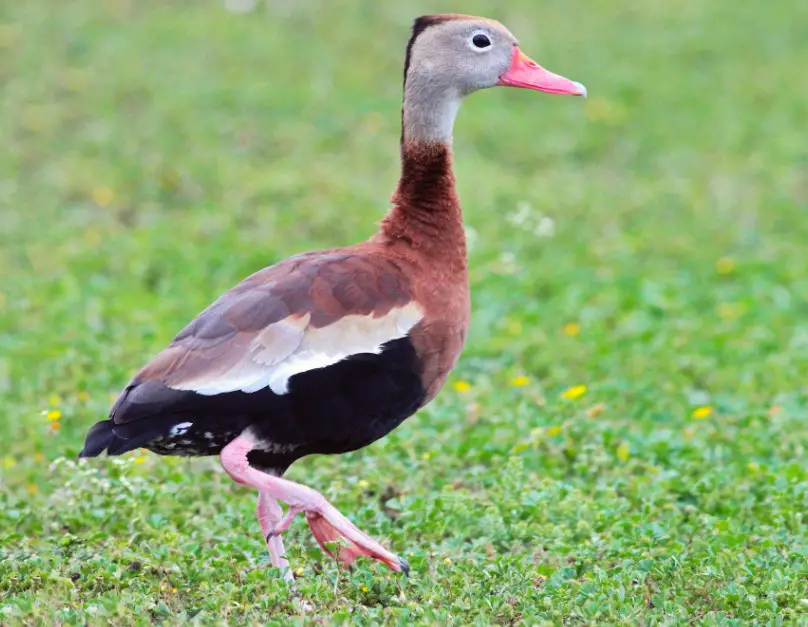
The Black-bellied Whistling-Duck is known for its bold and chaotic nature, often gathering in large, noisy flocks. True to their name, they produce a distinctive whistling call. Both males and females are tall with bright pink bills and long necks. Their bodies are mostly brown, with lighter patches on the head and back, black bellies, and white wing stripes that are visible in flight.
These ducks are commonly found in Texas and Louisiana, where they inhabit wetlands, fields, and even golf courses while foraging for seeds and grains. Unlike most ducks, they perch on trees and nest in tree cavities. Their gregarious behavior and striking appearance make them easy to spot in their preferred habitats. As whistling ducks, they belong to a unique family known for their vocalizations and social nature.
Blue Duck
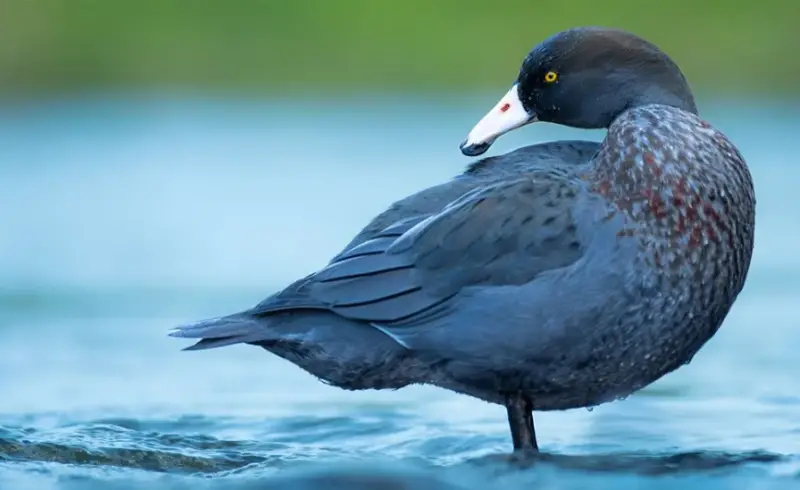
The Blue Duck, also known as “Whio,” is an endangered species unique to New Zealand. They have a bluish-gray body with a reddish chest, blending perfectly into the fast-flowing rivers and rocky habitats they call home. Their webbed feet are specially adapted for gripping slippery rocks, allowing them to thrive in turbulent waters.
These ducks are highly territorial and are usually found in pairs. Their diet mainly consists of aquatic insects and larvae, which they catch by diving or foraging among river rocks. Due to habitat destruction and predation by invasive species, their population has significantly declined. Conservation efforts in New Zealand, including predator control and habitat restoration, aim to protect this rare perching duck and increase its numbers.
Blue-Winged Teal
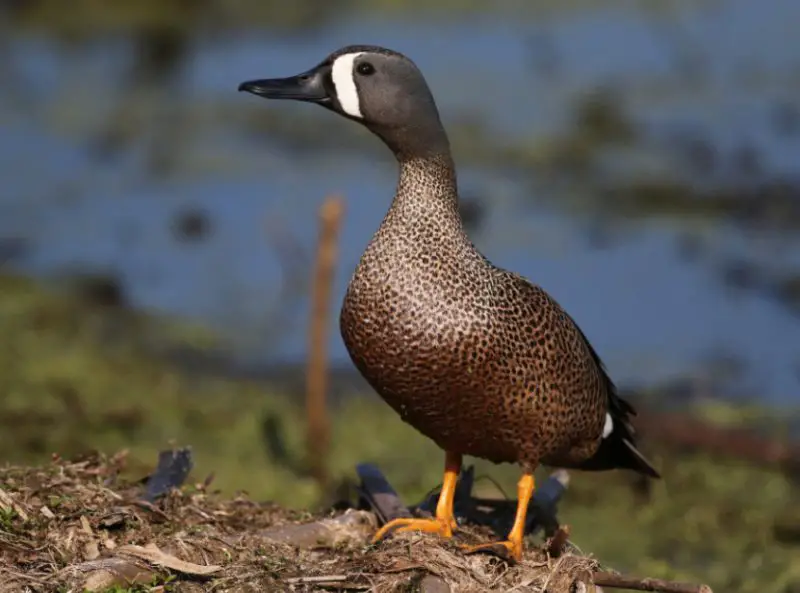
Blue-Winged Teals are small dabbling ducks known for their long migrations, traveling north in spring to breed in marshes across the U.S., except Hawaii. Males are easily recognizable by their purplish-gray heads adorned with a distinctive white crescent in front of their eyes. Their bodies are fawn-colored with black speckles, black wings, and a black tail. When in flight, they display sky-blue patches on their shoulders. In contrast, females are light brown with darker markings and a black bill.
These ducks prefer shallow wetlands, including marshes and ponds, where they feed on seeds, aquatic plants, and small invertebrates. They nest on the ground, often hidden among tall grasses for protection from predators. Blue-Winged Teals are highly social outside of breeding season, forming large flocks during migration. Their impressive journeys can take them as far as South America, making them one of the earliest ducks to migrate south in the fall.
Brazilian Duck
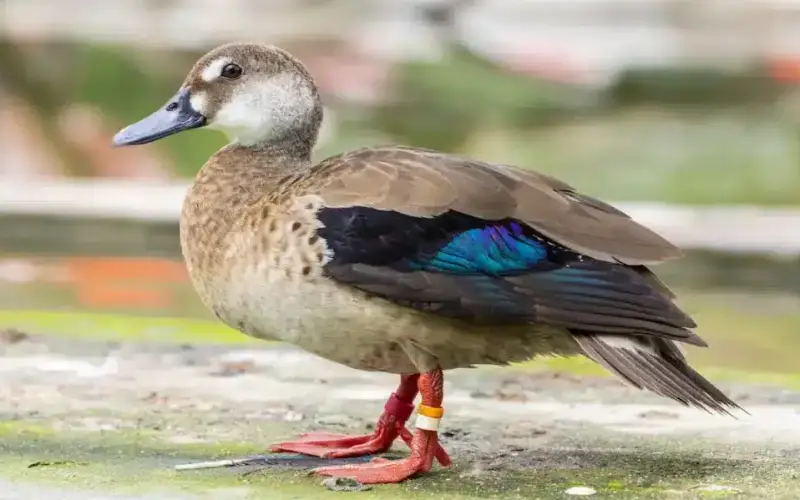
Also known as the Brazilian Teal, the Brazilian Duck is native to South America, commonly found in wetlands, marshes, and slow-moving rivers. At first glance, they appear to be plain pale brown ducks. However, they possess hidden vibrant blue wings that are visible during flight. Both males and females look similar, but they stand out due to their long necks and slender bodies compared to other ducks.
These ducks are known for their strong pair bonds and family-oriented behavior. Males are attentive fathers who help females care for the ducklings, which is unusual among duck species. They are perching ducks, often seen resting on low branches or logs near water. Their diet mainly consists of seeds, aquatic plants, and insects. Despite their broad range in South America, they are relatively shy and prefer secluded, vegetated areas for nesting.
Bufflehead
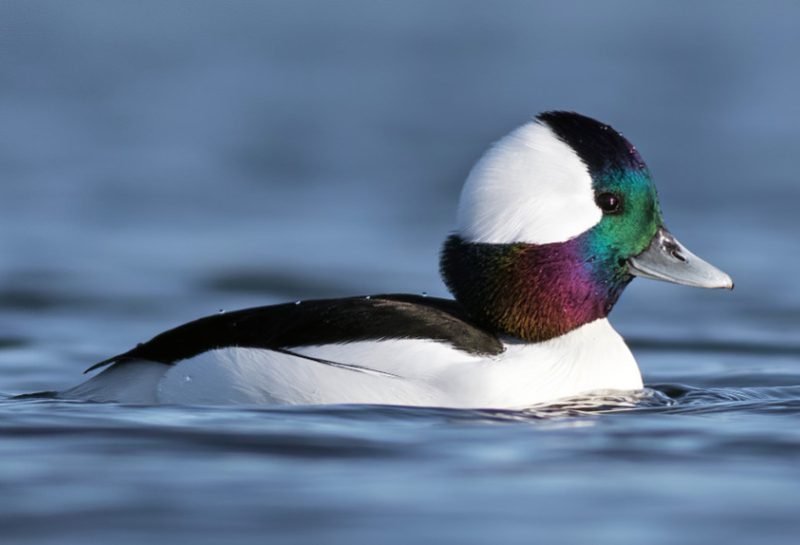
Buffleheads are small, energetic diving ducks known for their adorable, fluffy-headed appearance. Males have striking iridescent heads with a large white patch behind their eyes, contrasting with their black and white bodies. Females are more subdued, with dark heads featuring a horizontal white stripe and grayish-brown bodies. Despite their small size, they are powerful divers, quickly disappearing underwater to catch aquatic invertebrates.
These ducks are found across the U.S., except Hawaii, favoring freshwater lakes and coastal bays. They are cavity nesters, often using abandoned woodpecker holes for nesting. Buffleheads are highly migratory, breeding in North America’s boreal forests and wintering along coastal regions. Their playful nature and rapid, agile flight make them a delight to watch. As diving ducks, they primarily feed on insects, crustaceans, and small fish, contributing to their lively, active behavior.
Canvasback
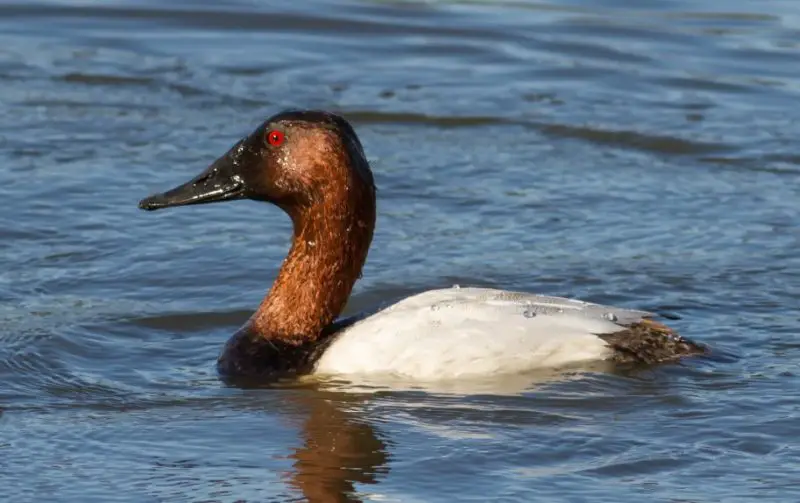
Canvasbacks are distinctive diving ducks known for their elongated heads and sleek profiles. Males are particularly striking, with a copper-red head, black chest, and pale silver back, accompanied by red eyes. Females are more subdued, with similar features but darker eyes. Both sexes have long, sloping dark bills that aid in foraging underwater.
These ducks are expert divers, feeding on aquatic vegetation, particularly tubers from the bottom of lakes and ponds. Canvasbacks inhabit freshwater lakes, marshes, and coastal bays across the U.S., except Maine and Hawaii. During migration, they gather in large flocks on major waterways. Their unique appearance and graceful diving abilities make them a favorite among birdwatchers. Conservation efforts have helped stabilize their populations, which were once at risk due to habitat loss and hunting pressures.
Cinnamon Teal
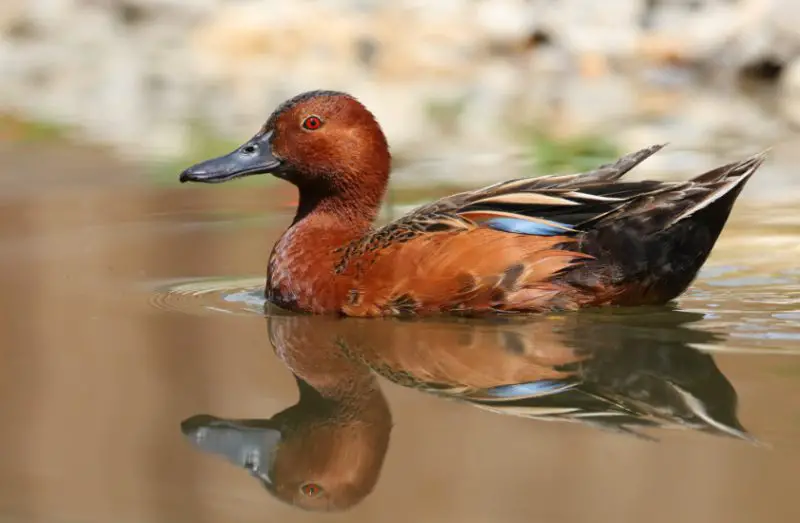
Cinnamon Teals are small dabbling ducks known for the rich cinnamon-colored plumage of the males during the breeding season. They also have hidden powder-blue shoulder patches visible during flight. Females are less vibrant, with light brown feathers marked by darker patterns. Both sexes have long, slightly curved bills adapted for filtering food from the water.
These ducks are found in the wetlands of the western U.S., with two distinct breeding populations: one in North America and another in South America. They feed on aquatic plants, seeds, and small invertebrates. Their preferred habitats include shallow lakes, ponds, and marshes. Due to declining numbers, Cinnamon Teals are on the conservation watch list, prompting efforts to protect their breeding and migratory habitats. Despite conservation challenges, they remain a favorite among bird enthusiasts for their striking colors and active feeding behavior.
Comb Duck
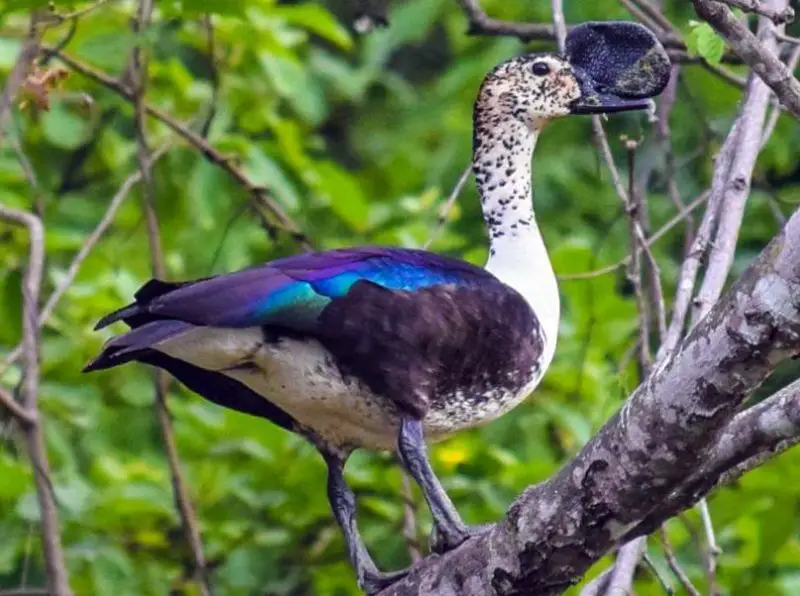
Comb Ducks are one of the most peculiar-looking ducks, known for their large size and unique appearance. Males have a thick, fleshy knob on their bill, which becomes more pronounced during the breeding season. Their plumage is striking, with a glossy black back and a contrasting white underside. Their faces are also white, speckled with black markings, giving them a distinctive look. Both males and females share this coloration, although males are slightly larger.
These ducks are perching waterfowl found in tropical wetlands across South America and Africa. They prefer habitats such as lakes, marshes, and slow-moving rivers, where they feed on aquatic plants, seeds, and small invertebrates. Comb Ducks are strong flyers and often nest in tree cavities or abandoned nests of other birds. They are social birds, forming small flocks outside the breeding season. Their unusual appearance and unique behaviors make them a fascinating species to observe in their natural habitats.
Cotton Pygmy Goose
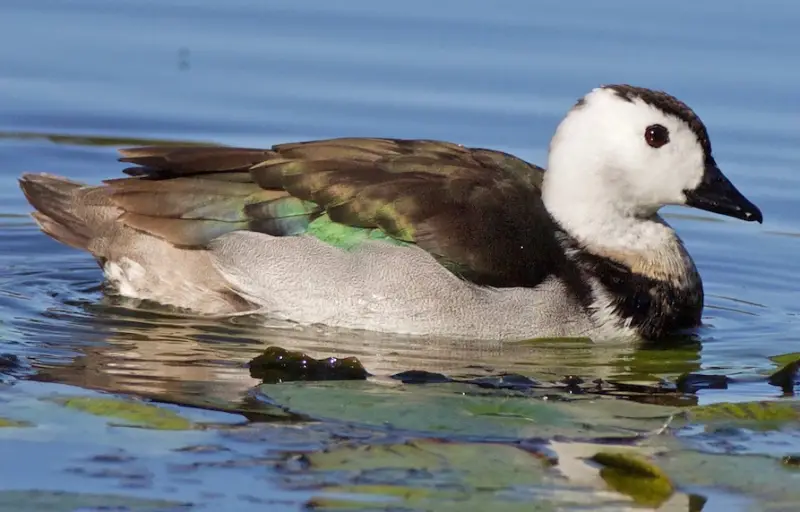
The Cotton Pygmy Goose is a small, beautifully colored perching duck native to Asia. These ducks are known for their agility in flight and are also capable divers. They nest in tree cavities, often near freshwater lakes and rain-filled ditches. Their petite size and quick movements make them hard to spot, but their stunning plumage leaves a lasting impression.
Males have a white body with a soft brown stripe that extends from the center of their head, widening over their back. This stripe is interspersed with iridescent teal feathers, creating a striking contrast. Their wings are vibrant blue-green underneath, and a distinct black V shape cuts across their chest. Females are more subdued in color but share the same elegant pattern. Cotton Pygmy Geese feed on aquatic plants and insects, thriving in calm freshwater environments. Their vibrant colors and lively behavior make them a delight to watch.
Eurasian Wigeon
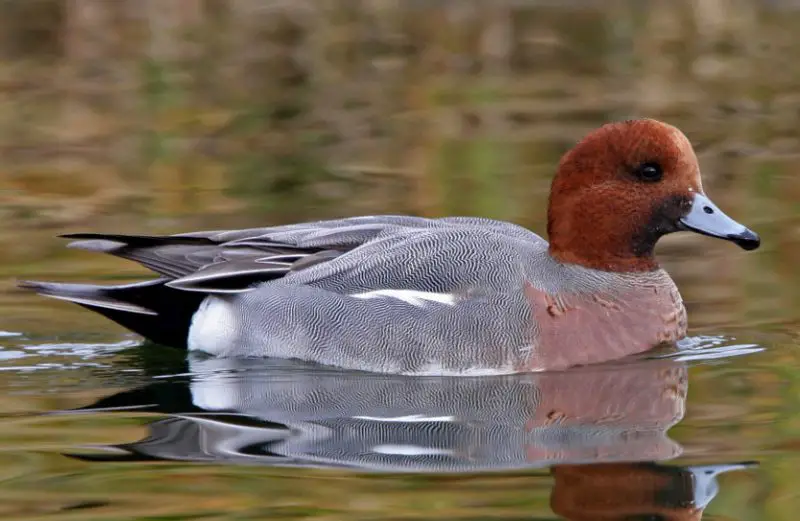
The Eurasian Wigeon is a dabbling duck typically found in Europe and Asia, but some individuals occasionally end up in North America by joining flocks of American Wigeons. Males are particularly eye-catching with a rich orange-brown head, a creamy buff forehead, and a red buff patch on their chest. Their bodies are intricately patterned with white and black stripes, giving a gray appearance from a distance. In contrast, females are a more uniform brown with darker markings but share the same white belly as the males.
These ducks are found in coastal wetlands, lakes, and marshes, especially along the Northeast Coast, Florida, Texas, Tennessee, and the Midwest. They are dabblers, feeding on aquatic plants, grass, and small invertebrates by tipping forward in the water. During migration, they are often seen in large flocks, mixing with other waterfowl species. Their striking colors and occasional appearance in North America make them a sought-after sighting for birdwatchers.
Gadwall
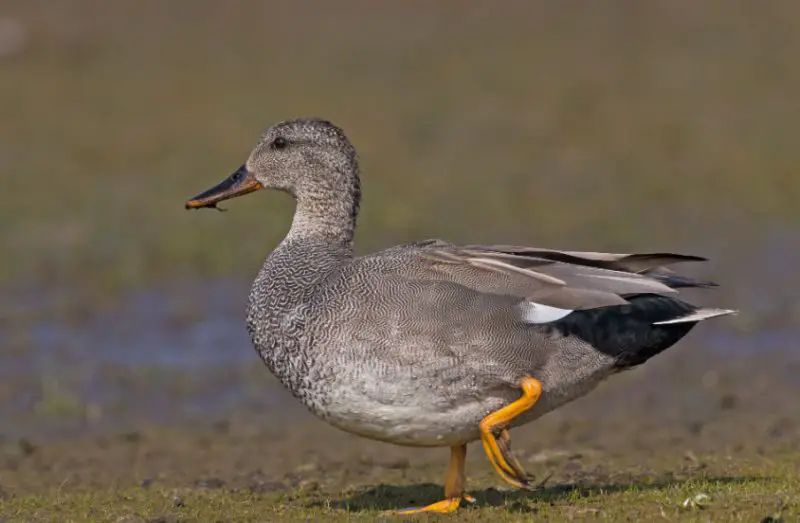
Gadwalls may look plain at first glance, but they are one of the most intriguing dabbling ducks due to their clever and bold behavior. Males have a subtle mix of gray and brown plumage, while females are light brown with darker markings. Although they lack bright colors, their intricate feather patterns are quite beautiful up close. Both sexes have white wing patches visible in flight.
These ducks are known for their sneaky habit of stealing food from diving ducks, such as American Coots. They are found in wetlands, marshes, and lakes across all U.S. states, except Hawaii. As dabblers, they feed on aquatic vegetation, seeds, and small invertebrates by tipping forward in the water. Gadwalls are highly adaptable, often thriving in human-altered habitats like reservoirs and agricultural fields. Their clever foraging tactics and understated beauty make them an interesting species to observe.
Goldeneye
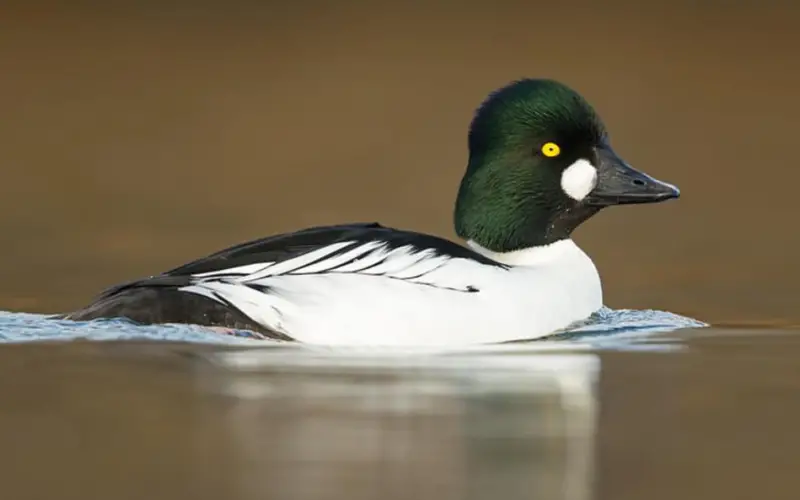
The Common Goldeneye is easily recognizable by its vibrant golden eyes, from which it gets its name. Males are striking, with glossy green heads, a white spot near the beak, and a stark contrast of white chest and flanks against a dark back and tail. Females are less colorful but share a similar body shape with brown heads and grayish bodies. Both sexes are excellent divers, feeding on aquatic invertebrates, small fish, and crustaceans.
These ducks are found in freshwater lakes and coastal bays across the U.S., except Hawaii. They are cavity nesters, typically using tree holes left by woodpeckers. Remarkably, Goldeneye ducklings leave the nest just one day after hatching, making a daring leap from heights of up to forty feet. Their fearless nature and vibrant eyes make them one of the most fascinating diving ducks to watch.
Greater Scaup
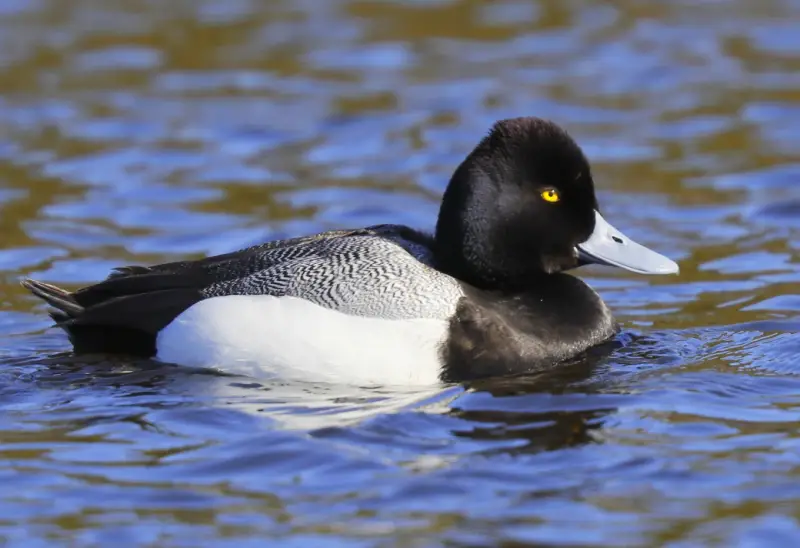
The Greater Scaup is a striking diving duck known for its rounded head shape, which helps distinguish it from other Scaup species. Both males and females share golden eyes and blue-gray bills, but their plumage differs significantly. Males have a glossy dark green head, with a body featuring shades of gray, white, and black. In contrast, females have a rich chocolate-brown head adorned with a distinctive white stripe near the bill, and their bodies are primarily brown.
These ducks are found across most U.S. states, except Hawaii and New Mexico, and inhabit coastal bays, lakes, and wetlands. They are skilled divers, feeding on aquatic invertebrates, small fish, and vegetation. Greater Scaups often form large, dense flocks during migration and wintering seasons. Their bold diving abilities and vibrant eyes make them an exciting species to watch in their natural aquatic habitats.
Harlequin Duck
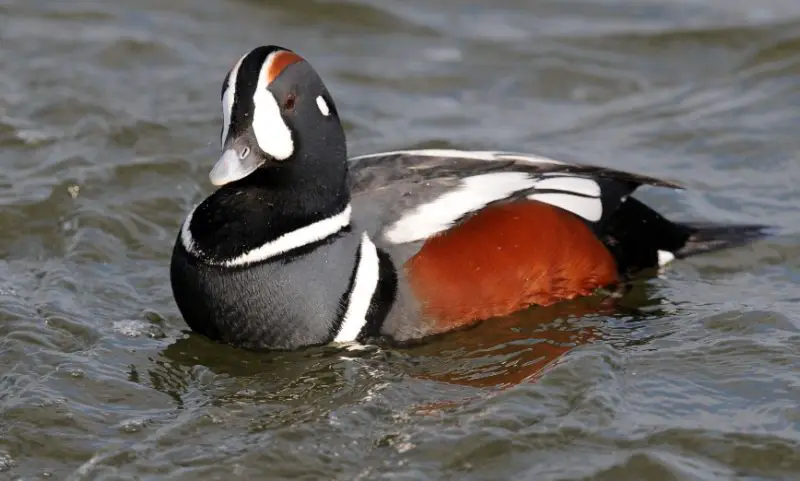
Harlequin Ducks are one of the most colorful waterfowl species, with males sporting a stunning mix of black, white, blue, and red plumage. Their vibrant colors are enhanced by striking white patches on the face and neck. Females, on the other hand, are more subdued with a muted brownish-gray color and small white spots near their eyes.
These ducks are famous for their preference for extreme habitats. They live along rocky coastlines and turbulent whitewater rivers in the Northwest and Alaska. The powerful waves they navigate are so rough that x-rays of wild Harlequin Ducks reveal healed fractures, evidence of their tough lifestyle. They dive skillfully to catch crustaceans and aquatic insects, thriving in rugged, fast-flowing waters. Their bold colors and remarkable resilience make them an unforgettable sight.
Hartlaub’s Duck
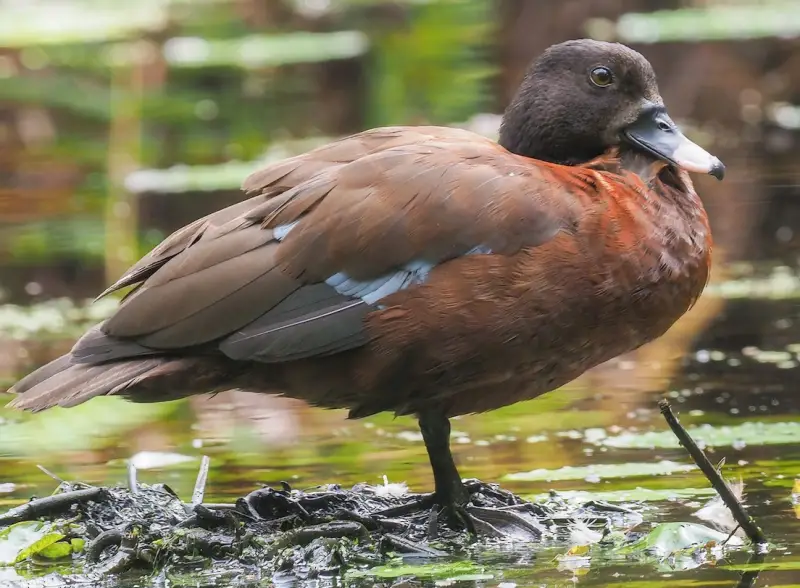
Hartlaub’s Duck is a unique perching duck native to Africa, known for its striking chestnut-brown body and contrasting black head. Its reddish-brown eyes stand out against the dark feathers, and a white stripe runs where the bill meets the face. The bill itself is mostly black, with a lighter section near the tip. These ducks are relatively small but have a charming, elegant appearance.
They inhabit dense forested areas near rivers and lakes across Africa. Unlike most ducks, they are believed to nest high up in tree cavities, although no wild nests have been documented yet. Their diet mainly consists of seeds, aquatic plants, and small invertebrates. Hartlaub’s Ducks are often seen in pairs or small groups, gracefully navigating the forest waters. Their elusive nature and beautiful plumage make them a rare but delightful species to spot.
Hooded Merganser
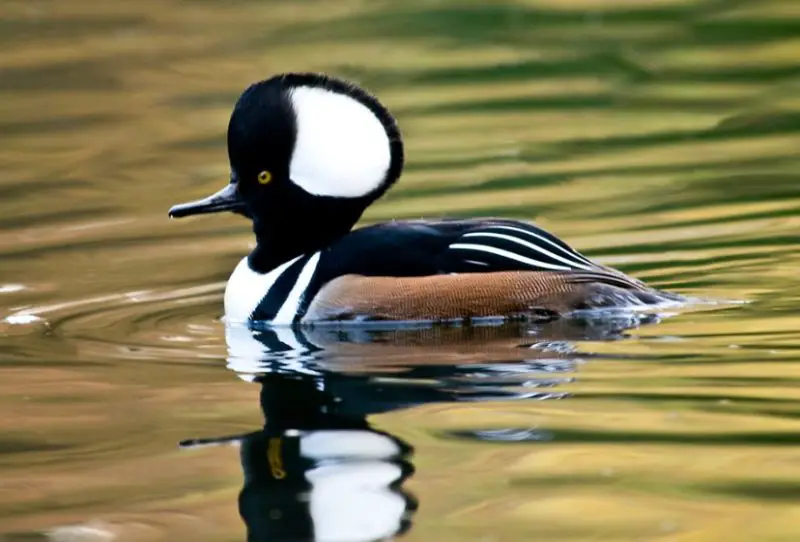
The Hooded Merganser is easily recognized by its spectacular crest, which can be raised or lowered to display different patterns. Males have a bold black and white crest that contrasts beautifully with their golden eyes and rich brown sides. Females are more understated but still striking with a cinnamon-brown crest and grayish-brown body. Both sexes share a slender, serrated bill perfect for catching fish.
These ducks are expert divers, using their sharp vision to hunt underwater. They even have a transparent third eyelid to protect their eyes while swimming. Found across all U.S. states except Hawaii, Hooded Mergansers prefer wooded ponds, rivers, and swamps. They nest in tree cavities and feed on small fish, crustaceans, and aquatic insects. Their elegant crests and exceptional diving skills make them a captivating species to observe.
Long-Tailed Duck
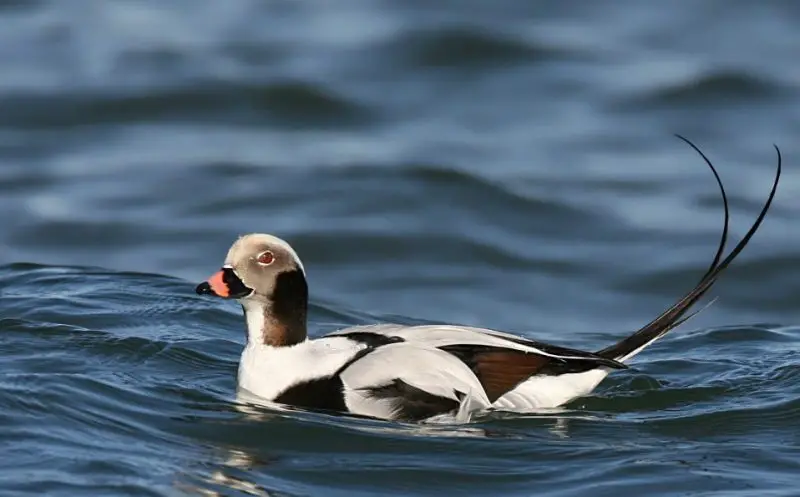
Long-Tailed Ducks are named after the males’ distinctive long tail feathers, which add an elegant flair to their appearance. Males undergo dramatic seasonal color changes. In summer, they are mostly black with a white face patch, whereas in winter, they turn predominantly white with a darker face. Throughout both seasons, they maintain their characteristic long tail feathers. Females, however, are brown and light-colored without the elongated tail.
These ducks are remarkable divers, capable of reaching impressive depths to catch fish and aquatic insects. They inhabit coastal waters along the Northern Ocean, including the Northwest, Northeast, and Alaska. Their high-pitched calls are a familiar sound in the Arctic tundra, where they breed. Long-Tailed Ducks’ striking plumage and exceptional diving abilities make them one of the most distinctive sea ducks to encounter.
Mallard
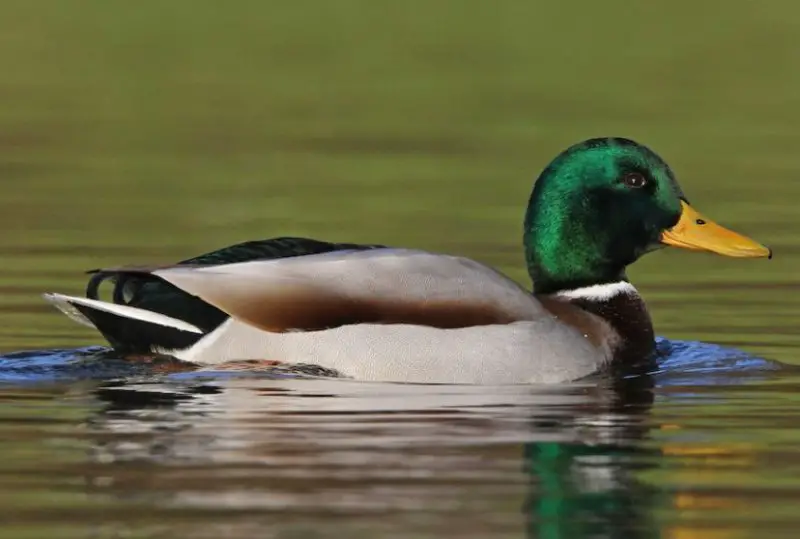
The Mallard is the most recognizable duck in North America, largely due to its widespread presence. Males are known for their stunning emerald green heads, bright yellow beaks, and gray bodies. Their vibrant plumage contrasts beautifully with the golden brown females, who have darker brown and black markings. Interestingly, only female Mallards can quack, making them the noisier of the two.
These ducks are highly adaptable and are found in almost all U.S. states, except Hawaii. They thrive in a variety of freshwater habitats, including lakes, rivers, and urban ponds. Unlike many other duck species, Mallards are known to mate for life. Their widespread distribution and charming appearance make them a favorite among bird watchers and casual observers alike.
Mandarin Duck
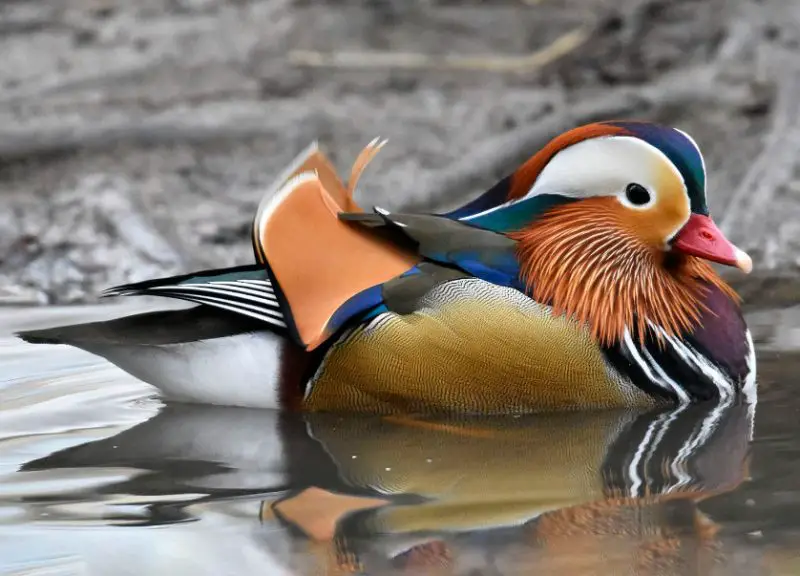
The Mandarin Duck is one of the most colorful ducks in the world. Males are a spectacular sight with a vibrant red bill and a striking mix of red, blue, green, white, and orange plumage. Their colorful feathers form a unique “sail” on their back, giving them an extravagant appearance. Females, in contrast, are more subdued with a brown-gray body and a distinctive white ring around their eyes.
Originally native to East Asia, Mandarin Ducks have been introduced to other parts of the world, including a small wild population in California. They naturally nest in tree cavities, showcasing their excellent perching ability. Despite their exotic look, these ducks are hardy and adaptable, thriving in both wild and urban settings. Their striking beauty and unique nesting habits make them a fascinating species to observe.
Maned Duck
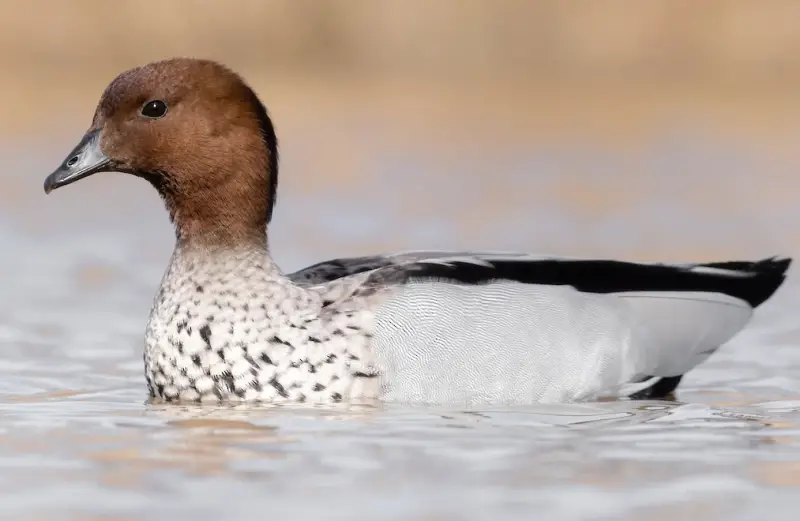
The Maned Duck, also known as the Australian Wood Duck, is native to Australia and is commonly seen in urban areas. Both males and females have a brown head and a short black bill. Males are distinguished by a tan and black speckled chest, while females feature a white line around their eyes and a more uniformly speckled brown and white pattern.
These ducks are known for their noisy behavior, especially when perched in trees. They inhabit woodlands, grasslands, and even parks, showing remarkable adaptability. Unlike many other ducks, they graze on land, feeding on grass and grains. The Maned Duck’s distinctive appearance and lively nature make it an interesting addition to Australia’s birdlife.
Common Merganser
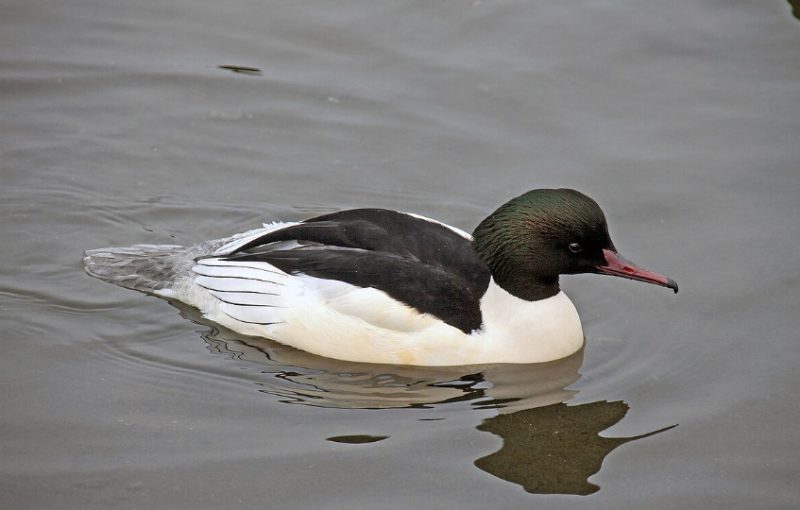
Common Mergansers are large, elegant diving ducks known for their striking appearance. Males have a glossy dark green head, a white body, and black back, whereas females have a gray body and a cinnamon-colored head with a distinctive shaggy crest. Both sexes have a bright red, serrated bill, which they use to catch fish.
They are exceptional divers, often plunging underwater to hunt fish and aquatic invertebrates. Common Mergansers prefer freshwater rivers and lakes in forested areas across the U.S., including the Northeast, Central, Northwest, and Southwest regions. Their streamlined bodies and hunting prowess make them fascinating predators in aquatic ecosystems.
Mottled Duck
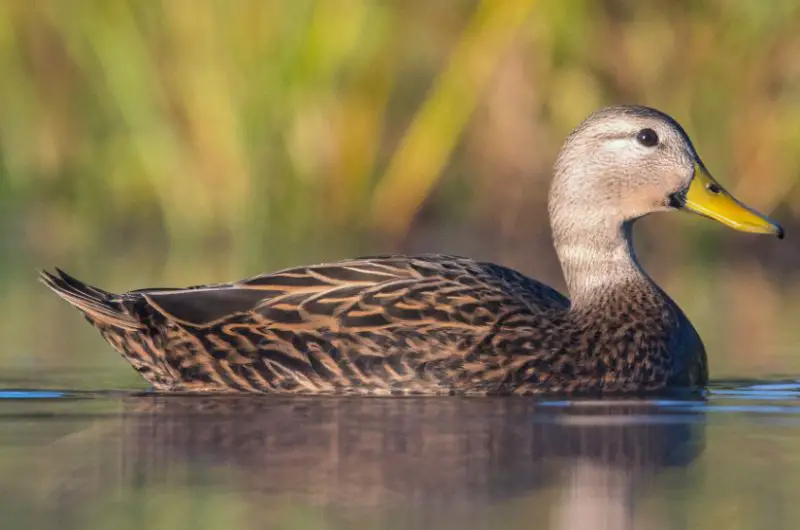
Mottled Ducks are medium-sized dabbling ducks known for their golden-brown bodies with dark mottling. Both males and females have a lighter head and neck with a dark cap, but males have a pale gray head, while females have a slightly tinted brown head. Their overall appearance is similar to female Mallards but with a richer golden hue.
These ducks are native to the Gulf Coast of the U.S., thriving in coastal marshes, freshwater wetlands, and rice fields. They feed on aquatic plants, insects, and small fish by dabbling at the water’s surface. Mottled Ducks are non-migratory and are known for their shy, elusive behavior. Their beautiful, subtly patterned plumage makes them a rewarding find for bird watchers.
Muscovy Duck
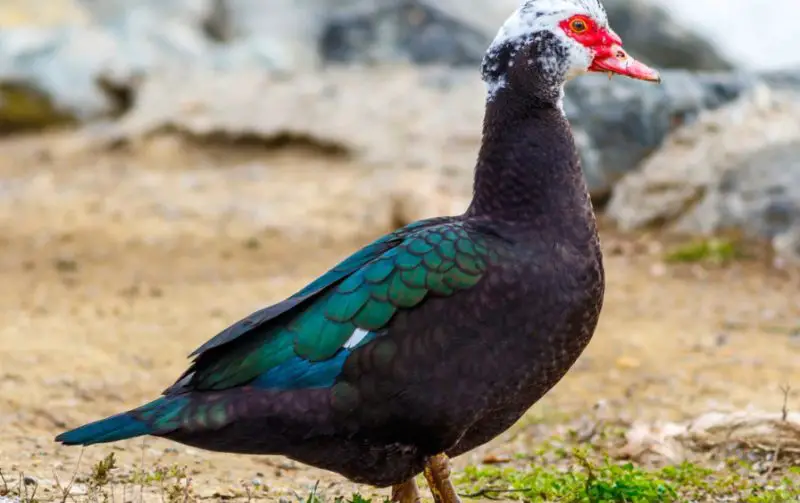
Muscovy Ducks are one of the oldest domesticated duck species, originally tamed by the native people of South America long before European explorers arrived in the 16th century. Today, they exist both as domesticated farm birds and as feral populations in Texas and Florida.
Males have a unique, almost vulture-like appearance due to the red, wart-like growths on their faces. Their feathers are predominantly brown and white with a stunning iridescent green sheen on their wings. In contrast, females are more elegant with glossy black feathers, a striking sapphire blue patch on their wings, and a smoother face without the red warts.
These ducks are perching waterfowl and are known for their quiet demeanor, often making a soft hissing sound instead of quacking. They are highly adaptable and can be found in a variety of habitats, including urban parks, wetlands, and farmlands.
Northern Pintail
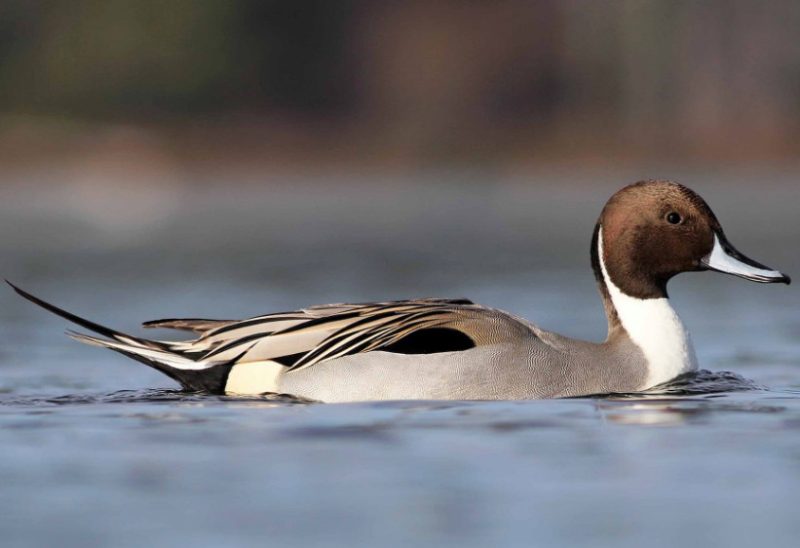
The Northern Pintail is renowned for its graceful and slender appearance, earning it the title of the “prince of the marshlands.” They are one of the first ducks to breed in the northern prairies of the U.S., often nesting as soon as the ice begins to melt.
Males are easily recognized by their long, elegant tail feathers, a rich chocolate-brown face, a white neck stripe, and a bright white chest. Females have a more subtle appearance with brown and tan plumage but maintain the signature slender neck that sets them apart from other species.
These dabbling ducks are highly migratory, seen across all U.S. states except Hawaii. They prefer shallow wetlands and are known for their agility in flight. Their beauty and grace make them a favorite among bird watchers and wildlife photographers.
Northern Shoveler
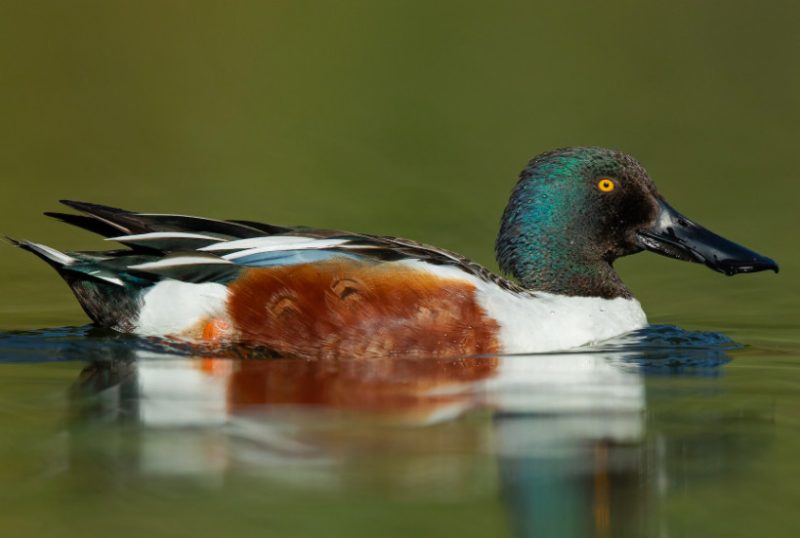
Named for their wide, shovel-shaped bills, Northern Shovelers are unique-looking dabbling ducks with an extraordinary feeding adaptation. Their bills have fine comb-like structures that allow them to filter small crustaceans and seeds from the water.
Males are vibrant with a green head, bright yellow eyes, a large black bill, a white chest, and reddish-brown flanks. Females are more muted in color, with light brown feathers and darker markings, but they share the same distinctive spoon-shaped bill.
These ducks are found in all U.S. states except Hawaii and prefer shallow wetlands and marshes. Their unusual appearance and specialized feeding habits make them a fascinating species to observe in the wild.
Pink-Eared Duck
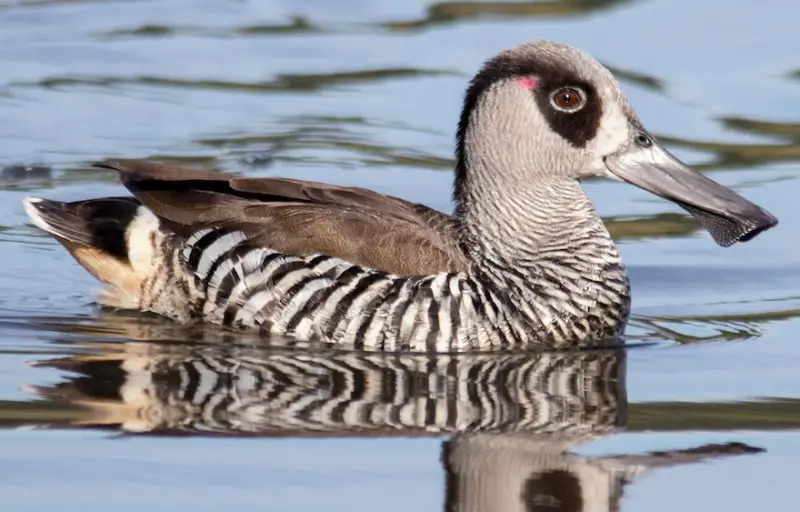
The Pink-Eared Duck is a strikingly exotic species native to Australia. They are named after the tiny pink spot of feathers near their ear, which is more prominent in males. They have a unique zebra-striped plumage, a dark shovel-shaped bill, and a rounded head.
Their specialized bill is designed for filtering microscopic plants and animals from the warm waters they inhabit. Pink-Eared Ducks are opportunistic breeders and are known to lay eggs at any time of the year, sometimes even taking over the nests of other bird species.
They are typically found in shallow lakes, swamps, and floodplains in Australia. Their distinctive appearance and unusual feeding behavior make them one of the most fascinating waterfowl species in the world.
Red-Breasted Merganser
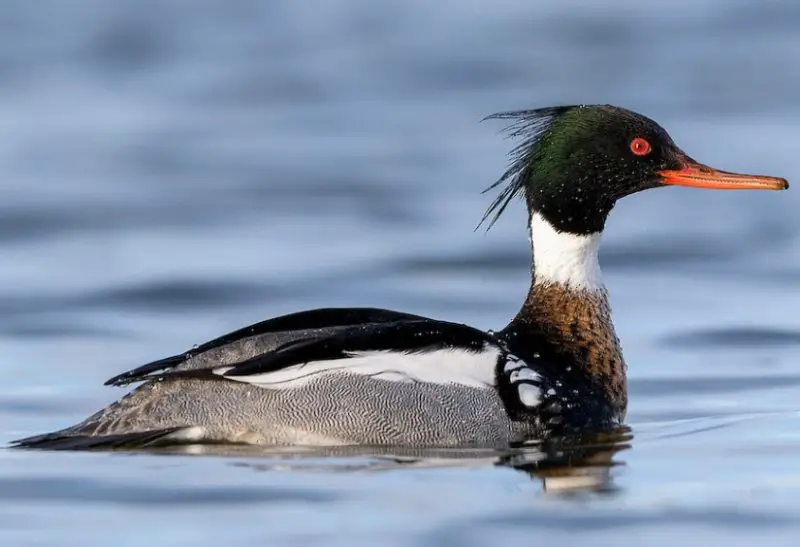
Red-Breasted Mergansers are sleek, diving ducks known for their striking appearance and impressive fishing abilities. Both males and females have a spiky crest on their heads, giving them a slightly untidy look.
Males are striking with deep red bills, red eyes, dark green heads, brown chests, and black backs. Females are more subdued with gray, brown, and white feathers, bright red bills, and darker red eyes. Both sexes have a serrated, sawtooth bill that helps them grip slippery fish, their primary diet.
These ducks are expert divers and are commonly found in coastal waters, lakes, and rivers across the U.S., except Hawaii. Their remarkable fishing skills and spiky crests make them a distinctive and charismatic species to watch in action.
Redhead
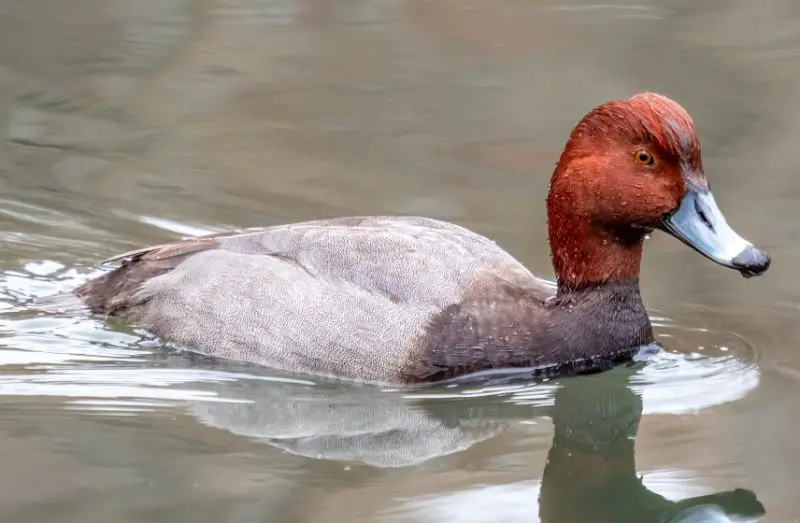
Redhead Ducks are named for the striking deep brown-red color of the males’ heads. They have light gray-blue bills with a dark tip, black chests, and white and black barred flanks. Females, on the other hand, are a plain shade of brown, making them less conspicuous than their male counterparts.
These ducks are well-known for their sneaky nesting behavior. Females often lay their eggs in the nests of other birds, leaving them to raise their ducklings.
They are diving ducks found across most U.S. states, except Hawaii, Maine, Vermont, and New Hampshire. Their preferred habitats include lakes, ponds, and coastal marshes, where they feed on aquatic plants and invertebrates.
Ringed Teal
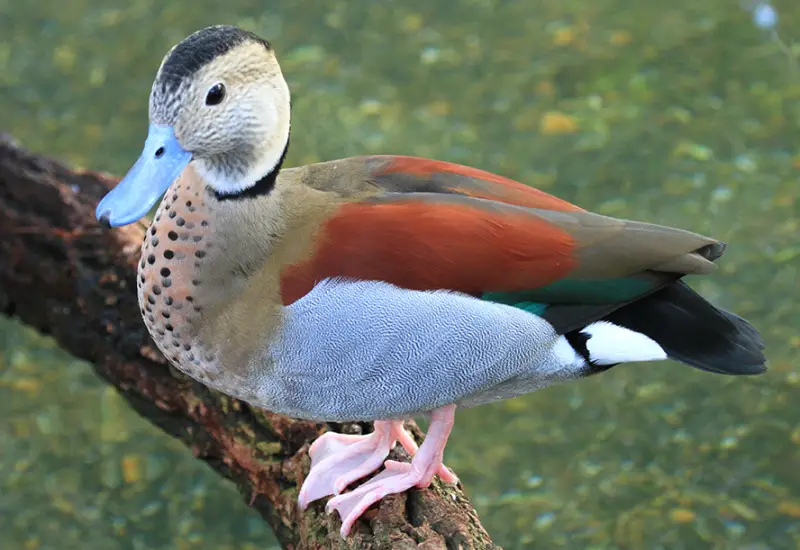
The Ringed Teal is a small, colorful duck species native to South America and is a popular choice for domestication due to its calm temperament and excellent mothering instincts. They are often used to hatch other ducks’ eggs but need to be protected from more aggressive bird species.
Males are easily identified by their light blue bills, salmon-colored breasts with black speckles, and tan heads with a distinctive black line running down the neck. They also have various colors and patterns on their flanks and backs. Females are more subdued, displaying a simple brown plumage.
As perching ducks, they are skilled at roosting in trees and are commonly found near wooded wetlands and rivers in their native range. Their charming appearance and gentle nature make them popular in aviculture.
Ruddy Duck
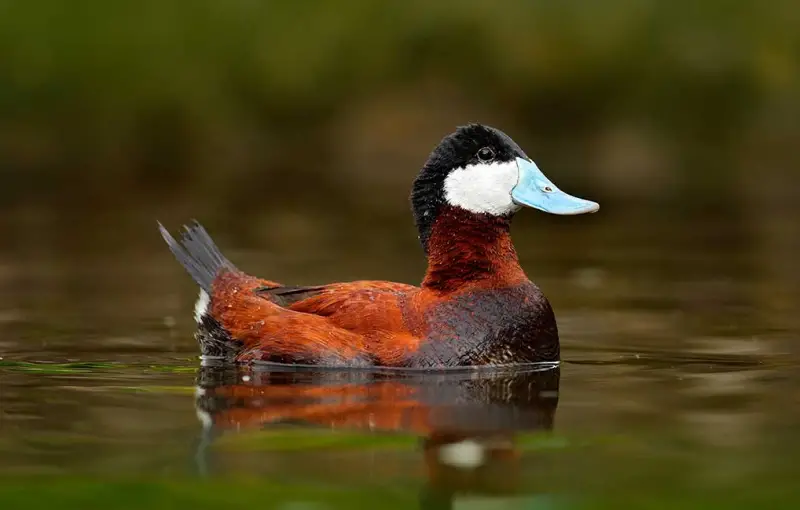
Ruddy Ducks, also known as Stiff-Tail Ducks, are easily recognized by their powder blue bills and stiff tail feathers that stand straight up at an angle. These small, bold diving ducks are known for their feisty behavior, sometimes even chasing away animals much larger than themselves.
Males have copper-brown bodies, a black cap on their heads, and bright white cheeks. Females are more camouflaged with various shades of brown.
They are found across all U.S. states except Hawaii and prefer freshwater lakes and ponds. Their diet consists mainly of aquatic invertebrates and plants. Their quirky appearance and bold personalities make them a favorite among bird watchers.
Torrent Duck
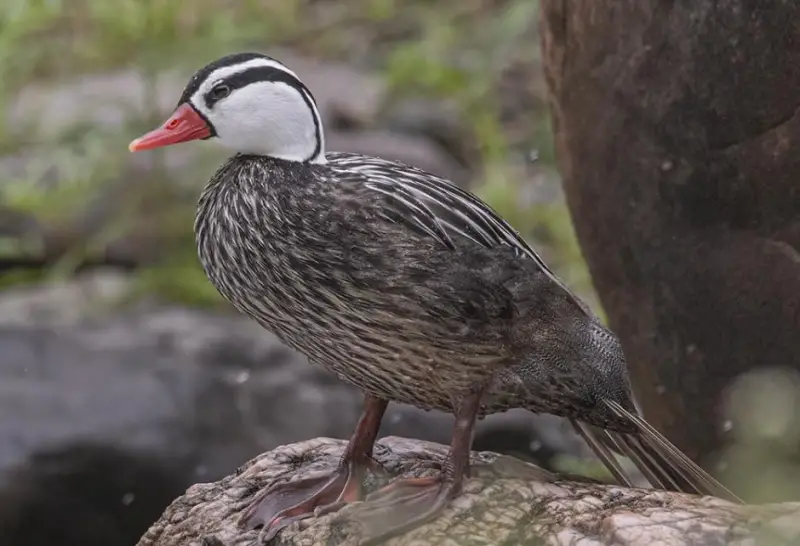
Torrent Ducks are uniquely adapted to fast-flowing rivers in South America and are one of the few duck species where females are more colorful than males. Females sport vibrant orange-red bellies and cheeks with bright red beaks, while males have black and white plumage with the same striking red beak.
They are exceptional swimmers and are often seen navigating turbulent waters with ease. Despite their aquatic prowess, they are categorized as perching ducks due to their habit of resting in trees.
There are three subspecies: Chilean Torrent Duck, Colombian Torrent Duck, and Peruvian Torrent Duck. Their unique adaptation to rugged river habitats and vibrant coloration make them a remarkable and captivating species to observe in the wild.
Wood Duck
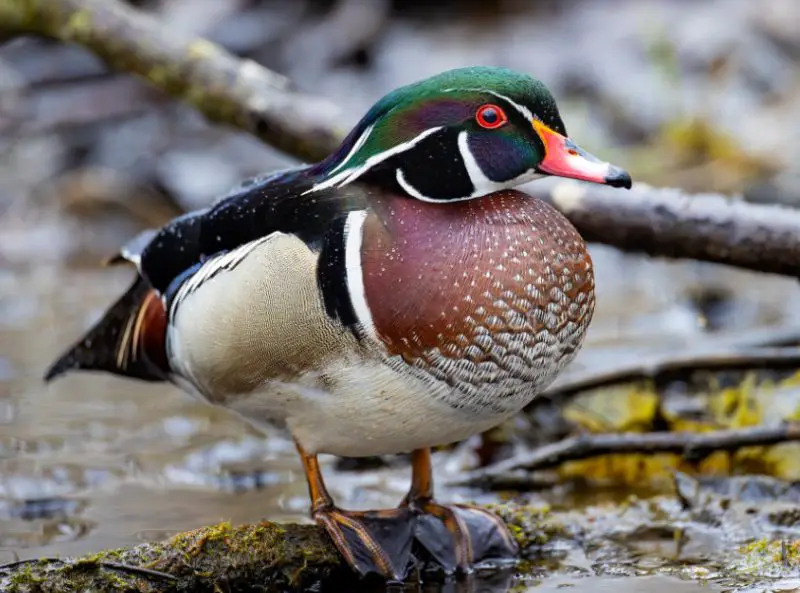
Wood Ducks are among the most ornamental ducks in North America, known for their vibrant and striking plumage. Males have long, iridescent crests and bold chestnut-colored chests, complemented by bright red eyes. Their vivid appearance makes them one of the most colorful waterfowl species in the U.S.
Females are also more distinct than most female ducks. They have soft dove-gray feathers with a unique white teardrop shape around each eye and colorful blue secondary feathers marked with a vivid white stripe.
Wood Ducks are the only native perching duck species in North America. They have strong claws that allow them to grip bark and nest in tree cavities. These ducks are found throughout the U.S. except for Hawaii, favoring wooded swamps, rivers, and ponds. Their beautiful appearance and unique nesting habits make them a favorite among bird watchers and wildlife enthusiasts.

